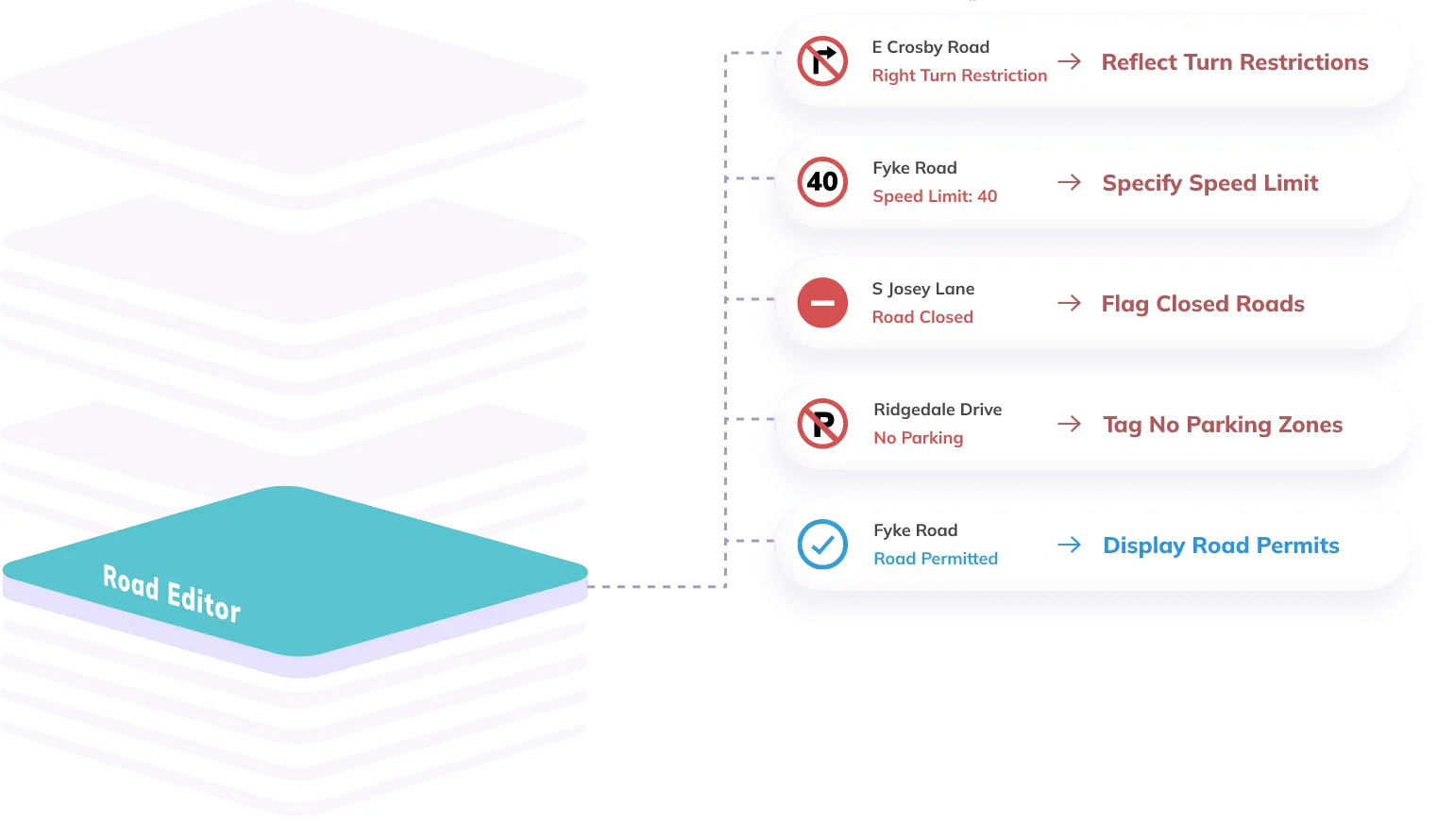

- BLOG
How to Build a Permit-Aware Routing Engine Using APIs
Published: November 10, 2025
Route Optimization API
Optimize routing, task allocation and dispatch
Distance Matrix API
Calculate accurate ETAs, distances and directions
Directions API
Compute routes between two locations
Driver Assignment API
Assign the best driver for every order
Routing & Dispatch App
Plan optimized routes with 50+ Constraints
Product Demos
See NextBillion.ai APIs & SDKs In action
AI Route Optimization
Learns from Your Fleet’s Past Performance
Platform Overview
Learn about how Nextbillion.ai's platform is designed
Road Editor App
Private Routing Preferences For Custom Routing
On-Premise Deployments
Take Full Control of Your Maps and Routing
Trucking
Get regulation-compliant truck routes
Fleet Management
Solve fleet tracking, routing and navigation
Middle Mile Delivery
Optimized supply chain routes
Construction
Routes for Construction Material Delivery
Oil & Gas
Safe & Compliant Routing
Food & Beverage
Plan deliveries of refrigerated goods with regular shipments
Table of Contents

When you use a routing API for real-world logistics, you quickly realize basic navigation isn’t enough. Many routes are governed by permits, access rules, or vehicle restrictions that standard systems ignore. If you manage fleets in logistics, construction, or waste collection, you’ve likely faced roads closed to trucks, hazmat routes, or local time-based restrictions.
That’s where building a permit-aware routing engine becomes essential. By integrating custom map layers and restricted segment data, you can ensure your routes comply with local regulations while staying efficient. In this guide, I’ll show you how APIs make it possible to plan smarter, compliant routes tailored to your operation’s needs.
A permit-aware routing engine is a system that calculates routes based on not just distance or travel time but also regulatory permissions, vehicle attributes, and time-based access rules. It accounts for restrictions like weight limits, hazardous material zones, seasonal closures, or vehicle-type permits while generating the best possible path.
Unlike a standard routing engine that focuses on speed or shortest distance, a permit-aware one integrates custom data layers and restricted segment information into its logic. This ensures that the generated route is legally compliant and suitable for the specific vehicle and cargo type.
For example, a regular routing engine might guide a truck through a low-emission zone or across a bridge with weight restrictions. A permit-aware routing engine, however, would automatically avoid these segments and suggest an alternate path based on your vehicle’s permits and restrictions.

Most routing APIs are built for standard navigation—finding the fastest or shortest path between points. While this works for general travel or delivery use cases, it doesn’t hold up in industries where permits, restrictions, and compliance rules shape how vehicles move. Here’s why traditional routing APIs struggle to meet regulatory and operational demands.
Traditional routing systems depend on fixed datasets that are rarely updated or lack regional accuracy. These datasets might include basic road types, speed limits, or traffic patterns, but they often ignore real-time or dynamic conditions.
For example, a city may impose a temporary truck restriction due to construction or seasonal closures on mountain routes. A standard API wouldn’t reflect these updates immediately, leading to invalid or inefficient routes. In compliance-heavy operations, such inaccuracies can result in fines, delays, or unsafe routing decisions.
Another major limitation lies in how traditional APIs treat vehicles. Most only recognize basic parameters such as car, bike, or truck—without deeper granularity. They don’t account for vehicle weight, axle configuration, cargo type, or height restrictions, all of which determine whether a route is legally and physically feasible.
For instance, a 12-ton truck carrying hazardous material might be routed through a tunnel that prohibits such cargo. Without permit-based routing or advanced vehicle attributes, APIs can’t prevent these violations or optimize for compliance.
Routing rules vary widely across regions, and most APIs aren’t built to accommodate this diversity. Municipalities often have no-truck zones, low-emission areas, or restricted bridges that apply only during certain hours. Traditional APIs use global datasets that overlook these localized restrictions, making them unsuitable for fleets operating across multiple jurisdictions.
This absence of custom map layer integration means dispatchers can’t visualize or avoid restricted areas, forcing manual workarounds that reduce efficiency and increase operational risk.
In short, the main routing API limitations stem from a one-size-fits-all design. To achieve permit-aware and regulation-compliant routing, systems must evolve to include custom map layers, restricted segment data, and dynamic rule integration. These capabilities ensure that every route respects both geography and regulation—essential for fleets operating in complex, compliance-driven environments.
A permit-aware routing engine combines multiple data sources and logic layers to create routes that are both efficient and regulation-compliant. Unlike standard routing systems that rely on general road and traffic data, this setup integrates custom datasets and permit logic to ensure vehicles only travel on authorized paths. Below are the key components that make this possible.
The routing API forms the foundation of the system. It computes optimal routes by analyzing road networks, real-time traffic, and various restriction parameters. Advanced APIs—such as the NextBillion.ai Route Optimization API—allow you to specify conditions like avoiding restricted roads, adhering to vehicle-specific rules, or applying dynamic “avoid” parameters.
Example use case: Optimizing routes for delivery trucks that must avoid low-clearance bridges and restricted tunnels.
Custom map layers add localized intelligence to the routing engine. These layers represent data overlays—such as weight limits, hazardous material restrictions, or time-based access controls—that standard maps don’t include. They help visualize and enforce region-specific regulations that affect vehicle movement.
Example use case: Defining city-specific HAZMAT zones where certain trucks are prohibited during business hours.
This component defines specific road segments that require permits or are completely restricted to certain vehicle types. By tagging these segments, you can instruct the routing API to avoid or conditionally use them based on vehicle credentials or time windows.
Example use case: Routing around seasonal forest roads that close during winter or bridges that have strict weight limits.
A permit database connects the routing engine to external permit management systems or local government datasets. This integration ensures routes reflect the latest regulatory permissions and automatically validate whether a vehicle holds the required permits.
Example use case: Checking DOT-issued truck permits or city clearance records before confirming a route.
When combined, these four components—routing API, custom map layers, restricted segment data, and permit database integration—form the core architecture of a permit-aware routing engine. Together, they enable precise, regulation-compliant routing across dynamic and highly controlled transport environments.
Building a permit-aware routing system involves combining routing intelligence with vehicle-specific and regulatory data. The goal is to ensure that every route respects permit conditions, vehicle limitations, and local access rules. Here’s a technical breakdown of how you can build such a system using modern Routing APIs provided by NextBillion.ai.
Start by selecting a routing API that allows you to import custom data layers and define restricted segments. The API should let you upload geo-referenced datasets for areas such as restricted zones, low-emission corridors, or permit-only bridges.
Example: NextBillion.ai’s Routing API supports real-time custom data ingestion using endpoints for custom layers and routing profiles.
For more details, refer to Zone-Based Allocations using Route Optimization API.
Gather restricted road data from open sources like OpenStreetMap, local DOT APIs, or permit management systems. Standardize this data in a format the routing API can process—typically GeoJSON or shapefiles.
Each restricted segment should include attributes like:
Road Segment API gives you the details of all the road segments within a specific geographic area.
After preparing your restricted segment data, the next step is to create and upload custom map layers that reflect real-world regulatory and safety constraints. These layers act as data overlays on top of your base map, guiding the routing engine to avoid restricted zones and choose compliant paths.
Using a Routing API like NextBillion.ai’s Directions API and Navigation API, you can model complex restrictions—such as hazardous material routes, low-emission zones, or weight-limited bridges—and dynamically apply them to your routing logic.
For instance, when dealing with hazardous cargo, it’s not enough to simply avoid residential areas or tunnels. You must ensure that the route complies with HAZMAT transport regulations. NextBillion.ai’s APIs simplify this by using the hazmat_type parameter within the routing request. This parameter lets the engine recognize the type of hazardous material being transported and automatically restricts routing to legal and safe corridors.
Here’s an example setup:
{
“origin”: [77.5946, 12.9716],
“destination”: [77.6411, 13.0033],
“mode”: “truck”,
“option”: “flexible”,
“hazmat_type”: “flammable”
}
This request instructs the routing engine to:
In addition to the hazmat_type logic, you can upload custom map layers that define:
Each custom layer can be tagged with metadata such as { “avoid”: “hazmat_zone” } or { “permit_required”: “city_clearance” }, enabling the routing API to make context-aware decisions.
By combining hazmat-specific routing parameters with custom map layers, your routing system can deliver fully compliant, context-sensitive paths for any vehicle type—whether transporting standard goods or hazardous materials.
Define vehicle properties in the routing request using the vehicles array. Each vehicle object should represent its operational and physical constraints.
Here’s a sample configuration:
“vehicles”: [
{
“id”: “Truck_01”,
“description”: “HAZMAT transport vehicle”,
“start_index”: 0,
“end_index”: 12,
“capacity”: [10000],
“time_window”: [1730880000, 1730916000],
“skills”: [1, 2],
“max_tasks”: 5,
“costs”: {
“per_km”: 1200
},
“speed_factor”: 0.85,
“allowed_zones”: [101, 102],
“restricted_zones”: [201, 202],
“volume”: {
“width”: 2.5,
“depth”: 6.0,
“height”: 2.5
}
}
]
This configuration tells the routing engine to only assign jobs that comply with the truck’s permits, dimensions, and allowed zones. It also limits the route based on distance, working time, and vehicle type.
Once the vehicle attributes and custom map layers are ready, configure your routing parameters in the API call.
Example parameters include:
The routing engine now calculates paths based on both map-based restrictions and vehicle capabilities.
Run test routes through your API and compare the generated paths with real-world constraints. Validate against known restrictions to ensure compliance. Then, refine the logic using real-time feedback loops—for instance, updating restriction layers or modifying vehicle profiles based on permit changes.
Use APIs that support dynamic “avoid” lists, allowing you to modify restricted areas without reloading datasets. This flexibility helps the routing engine adapt to temporary regulations, such as construction detours or special event closures.
By following these steps, you can build a scalable, permit-aware routing system that intelligently adapts to vehicle profiles, dynamic restrictions, and compliance data. This architecture ensures your routes are optimized for both efficiency and legality, making it ideal for logistics, construction, and regulated freight operations.
A permit-aware routing engine adds a crucial layer of intelligence to route planning by integrating regulatory data, vehicle profiles, and local restrictions. This approach not only improves operational efficiency but also strengthens compliance and safety across all fleet operations. Here are the key benefits you can expect:
By incorporating restricted segment data and permit validation, the routing engine ensures that vehicles only travel on approved routes. It automatically avoids roads with permit-based restrictions or regulatory bans—reducing the risk of violations, fines, and delivery delays. This is especially important for fleets handling hazardous materials or heavy-duty loads where compliance lapses can have significant legal and financial consequences.
A permit-aware system aligns every route with safety regulations and vehicle-specific capabilities. It accounts for factors like weight limits, hazmat restrictions, bridge capacities, and time-based access rules. The result is a safer driving environment, fewer incidents, and better adherence to industry safety standards. Dispatchers gain confidence that every route generated meets both operational and regulatory requirements.
Traditional routing systems often fail in regions with frequent policy changes or detailed zoning rules. A permit-aware routing engine handles these conditions seamlessly by using custom map layers and real-time restriction updates. Whether it’s navigating through industrial zones, port areas, or low-emission corridors, you get high route accuracy even in complex environments.
As your fleet grows, so do your regulatory challenges. With a permit-aware system, expanding into new regions doesn’t require rebuilding routing logic from scratch. You can simply add new datasets or local rule layers to accommodate new jurisdictions. This modular approach ensures scalability and minimizes engineering overhead when adapting to regional transport laws.
In essence, a permit-aware routing engine transforms route planning from a generic optimization task into a compliance-driven decision process—helping fleets stay efficient, safe, and legally compliant no matter where they operate.
Building a permit-aware routing engine isn’t just about integrating APIs—it’s about managing the complexity of real-world transport regulations. From incomplete datasets to evolving local laws, several challenges can disrupt accurate route computation. Here’s a look at the most common issues and practical ways to address them.
Challenge: Many routing systems fail to reflect local or temporary restrictions due to missing or outdated datasets. This leads to inaccurate routes and potential compliance risks.
Solution: Partner with local GIS providers or combine OpenStreetMap (OSM) data with Department of Transportation (DOT) datasets to fill these gaps. Local partnerships ensure you capture municipal-level restrictions, such as seasonal closures, truck bans, or low-emission zones that global datasets may overlook.
Challenge: Regulations—especially around hazardous materials, axle weights, or time-based access—change frequently, and static datasets can’t keep up.
Solution: Use dynamic routing APIs that support real-time restriction updates. APIs like NextBillion.ai’s Routing API and Navigation API allow you to refresh or override restriction layers instantly, ensuring your routes always reflect the latest legal requirements without manual intervention.
Challenge: Developing and maintaining a permit-aware system can be costly if the APIs require heavy customization or proprietary data models.
Solution: Opt for modular APIs that support incremental integration and flexible pricing models. This approach lets you scale functionality—such as restricted segment handling or permit validation—without overhauling your existing infrastructure. It reduces both initial setup and long-term maintenance costs.
By addressing these challenges early, you can build a scalable and compliant routing engine that adapts to regulatory shifts and operational growth—without compromising data accuracy or system flexibility.
A permit-aware routing engine bridges the critical gap between regulatory compliance and operational efficiency. By integrating APIs that handle real-time restrictions, permit validation, and localized map layers, you can design routes that are not only optimized for time and distance but also fully compliant with transport laws and safety requirements.
If you’re building such a system, consider exploring NextBillion.ai’s Routing APIs. It enables custom configurations for vehicle types, hazardous material handling, and regional restrictions—helping you develop smart, permit-compliant routing solutions tailored to your operational needs.
Shivangi is a seasoned Technical Writer with a passion for simplifying technical concepts. With over 5 years of experience, she specializes in crafting clear and concise documentation for various technical products and platforms.